Ranking The Best Boat Bilge Pumps On The Market
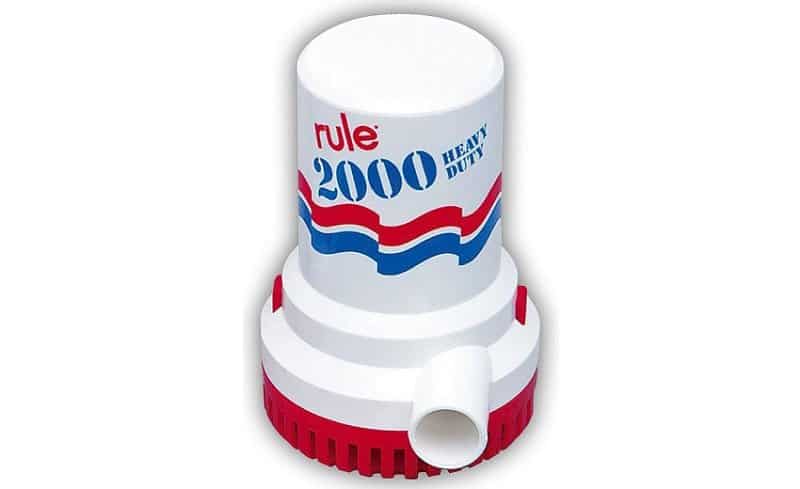
Rule 2000 Non-Automatic Pump
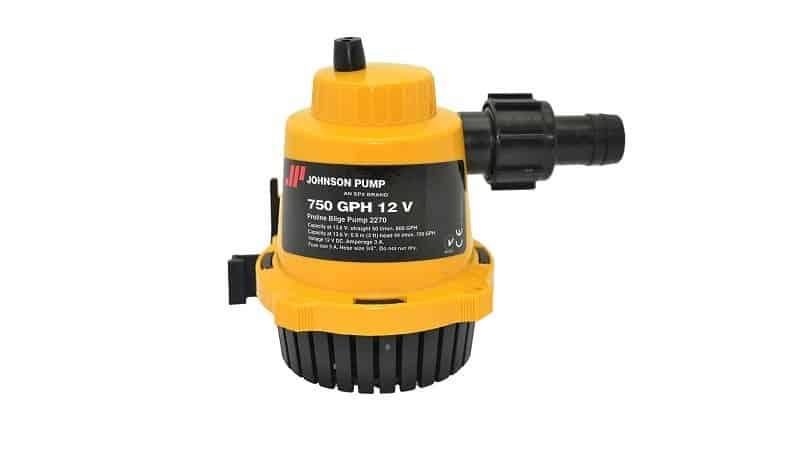
Johnson Pro-Line Marine Pump
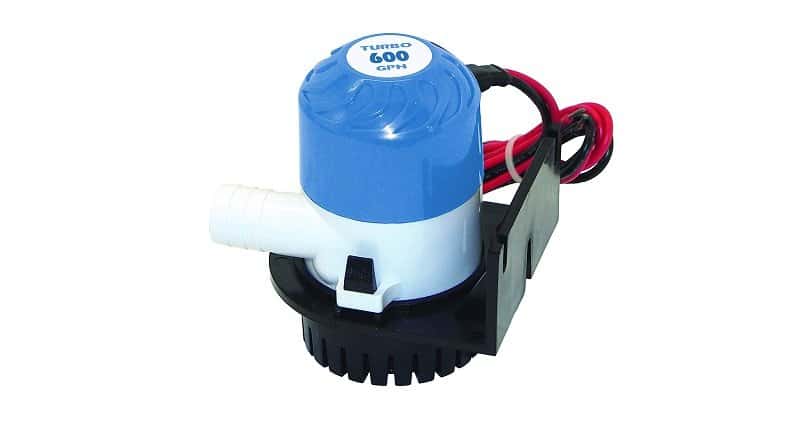
Shoreline Marine 600 Pump
If you’re a regular boater you’ll know just how persistent water can be. Even the best sealed hulls can be penetrated. Water finds a way of ending up in your hull; it can be rain water, it can be the result of a rogue wave or two, and sometimes, it can be from a leak. While a bit of rain and a small puddle of water from a wave won’t sink you, they’re not ideal to have standing around.
Excess water can cause your boat to become unstable. It will be harder to handle and may not respond to your steering so well. And that’s why you need a bilge pump. A good bilge pump will keep your boat water-free and running true. That’s why we’ve put together a helpful list of the best bilge pumps currently for sale!
But before we get started, what is a bilge pump and what do you need it for?
What Is A Bilge Pump?
A bilge pump is a special device that safely removes water from the bilge section of a vessel. The bilge is the lowest interior part of a boat’s hull. It’s where excess water collects, usually rain water or from waves. A pump’s job is to remove that water using either pressure or a vacuum-like suction, and pumping it overboard. Too much bilge water can cause a boat to sink. And that’s not what you want!
Do you need one though? Yes. Having a bilge pump is a good idea, even if you only own a kayak or a little rowing boat. Small hand bilge pumps are great for that. If you have a large boat, then you’d certainly need one. If you have a very large boat with multiple hull compartments, then you’d probably need one for ever compartment too.
But which pump is the best one to buy?
Rule 2000 Non-Automatic Pump

Rule are an industry leader when it comes to marine pumps, so you can rely on the quality of their products. This pump, the Rule 2000, is a versatile pump that can be used for a wide range of applications and vessel sizes. Ideally suited for boats up to 28 ft, the 2000 model is able to pump water up to 10ft in height vertically, or up to as much as 20 ft both horizontally and vertically.
The Rule 2000 bilge pump isn’t automatic, so it needs to be paired with a sensor or a float switch. You will also need to fit it to a panel-mounted on, off, and auto, switch to make the most of this pump. It’s available with three voltage options, 12 volt, 24 volt, and 32 volt.
It’s a highly efficient pump that’s completely submersible, and as its name suggests, it’s capable of pumping up to 2000 GPH, which is an absolutely enormous figure compared with other pumps on the list. If you have a large boat, this might not be enough, but Rule have a number of larger sized pumps that will certainly meet your requirements.
Compared with some others on the list, this is quite an expensive product, but it’s worth the money. Many reviewers have tried cheaper products, and with some degrees of success too, but many of them find themselves coming back to Rule bilge pump products time and time again.
Pros
Very powerful pump with compact design
100% submersible pump
3 Year manufacturer’s warranty
Pump Capacity: 2000 GPH
Johnson Pro-Line Marine Pump

This Johnson bilge pump is a great all ‘rounder. It boasts impressive statistics, comes at an affordable price point, and is built to the high standard that you’d expect from a brand like Johnson Pumps of America. It’s manually-activated pump with a decent flow rate, wrapped in a compact package with easy installation.
It’s a fully-submersible pump with an output of 750 GPH. Each pump comes equipped with ignition protection, anti-air lock protection, and a ¾ inch outlet diameter which can accept after-market hoses with ease, should you want to move the outpouring water to a specific location. It also features a base strainer to help keep the pump clean.
Since it’s a manual bilge pump, it needs to be turned on before it can operate. However, it can easily be turned into an automatic device by installing a float and a float switch.
Each pump passes through a rigorous quality assurance process before being shipped, with each product being 100% factory tested. The reliability is one of the reasons that many boat operators choose this unit. That, and the fact that it’s often a perfect replacement for OEM pumps.
It also ships with a 3 year warranty, which should make this inexpensive marine pump an appealing purchase.
Pros
Low-maintenance, high-performance pump
Anti-airlock protection
3 year manufacturer’s warranty
Pump Capacity: 750 GPH
Shoreline Marine 600 Pump

This small pump is the best automatic bilge pump if you’re looking for an inexpensive, small, and compact pump with a modest pumping capacity. It’s fully submersible too, which means you don’t have to worry if you need it to operate underwater.
It’s very simple to install, and doesn’t require too much technical know-how to get it running. It features marine grade bilge pump wiring, a low operating current, and ignition protection. It’s a manual pump—meaning that it needs to be switched on to operate—but it can be made automatic with the installation of a few extra parts. A float and switch is required if you’re hoping for automatic operation, so factor that into your costs.
Each pack comes with a mounting bracket, stainless steel hardware, tinned marine grade lead wires, a universal mounting base, and a wiring diagram to help point you in the right direction during installation.
Though it’s rated at 600 GPH, many reviews have stated that this figure might be a little optimistic. However, if you’re looking for an inexpensive pump that will do the job, but perhaps not as fast others, this is the one for you—providing that you’re only operating a small vessel though.
Pros
Universal mounting system
Hose attachment for ¾” I.D. bilge hose
Quiet operation
Pump Capacity: 600 GPH (claimed)
Seattle Sports Paddler’s Bilge Hand Pump
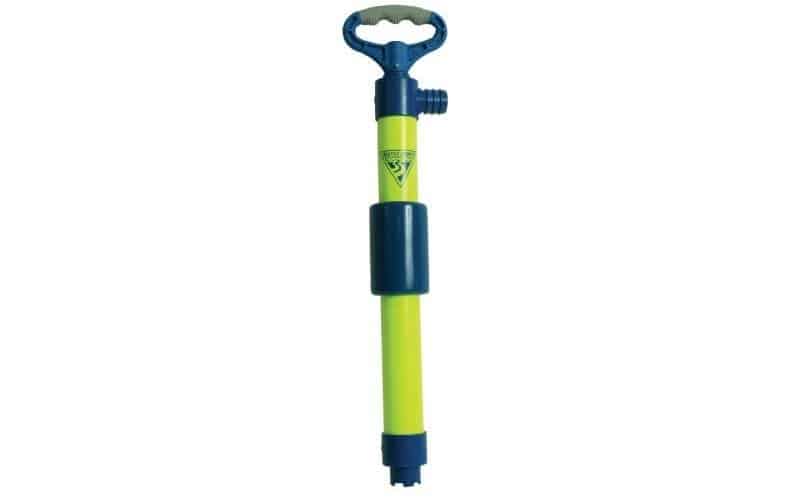
We decided to kick-start the list with a manual bilge pump. It’s not automatic, electric, or powered by anything except from your own sweat and elbow grease. This budget-focused hand pump is perfect for clearing small volumes of water that may have infiltrated your hull.
The actual pump is fairly simple to operate. It sucks in water when you pull the handle, and disperses it when you push it down. It has been designed to accommodate a hose if you need to move your water to a specific location. The ergonomic handle is coated in an easy-grip rubber for comfort, making it breeze to use, even in challenging conditions.
Seattle’s sports pump is 12 inches long, with a diameter 1.75 inches. It features a special foam collar that keeps the pump afloat if it accidentally falls overboard, with a high-visibility neon yellow finish to make it easy to spot.
The Seattle Sports Paddler’s pump is capable of displacing up to 480 GPH, but achieving that kind of performance demands constant pumping, so it’s not actually for large water craft. However, these small devices are ideal for a kayak bilge pump, or for small inflatable boats. They can also be used as a backup pump for larger vessels, but we don’t recommend relying on one of these in an emergency.
Pros
Easy-to-operate hand pump
High-visibility finish
Floats on water
Pump Capacity: 480 GPH
SeaSense Bilge Hand Pump
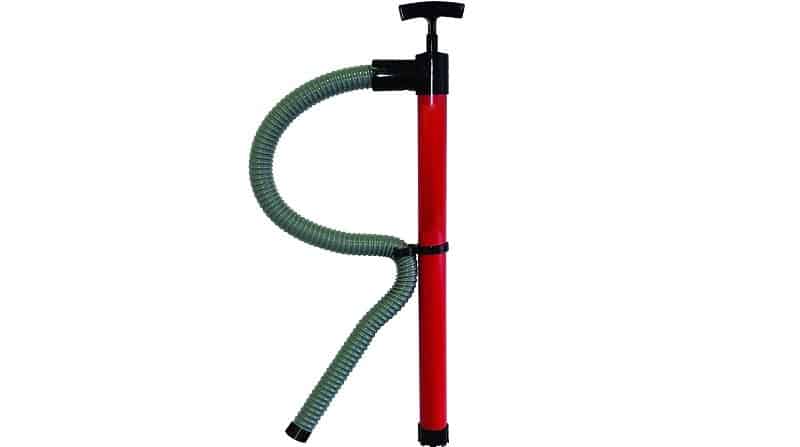
Next, we’ve got another hand bilge pump. In truth, this model from SeaSense is very similar to the Seattle pump listed above, but there are some differences that might make it a more suitable option for some boaters. Since hand pumps are fairly rudimentary there aren’t many features that make one better than other.
The SeaSense pump has a tubular shape with a large pumping handle. The handle isn’t particularly special but it’s comfortable enough for repetitive pumping, and large enough to fit most hand sizes. Like most hand pumps, you pull the handle to draw in water, and push it back down to push the water out. This one comes with its own hose though, so you don’t have to attach your own. The ribbed hose is 36 inches long, and screws directly into the pump.
If you pump for around 3 minutes with moderate effort, it’s possible to displace up to 40 gallons of water—which is quite efficient. It’s actually possible to displace up to 800 GPH, if you’ve got the energy to keep pumping for a full hour.
One of the best features of this pump is that it comes in a variety of sizes. This means you can select a model with the right length and diameter for your needs. Naturally, if you choose a larger diameter that displaces more water per pump, then you’ll have to pay a little bit more for the pleasure.
Pros
Inexpensive pump for small vessels
36 inch hose as standard
Lightweight and easy to store
Pump Capacity: 800 GPH
Attwood Sahara Automatic Marine Pump

This Attwood bilge pump is an ideal choice for those looking for a pump with automatic activation. It switches on when it interacts with water, sucking out any excess water when necessary, leaving you to focus on other tasks, or relax. It’s an affordable low-maintenance, low-effort solution.
Attwood has been at the forefront of marine technology for over 100 years. The brand has developed a reputation for the manufacture of reliable and high-quality marine goods, from efficient fuel systems to swim ladders and lighting. You can really rely on their products.
The Sahara model is more than capable of shifting a lot of water in a hurry, so it’s a good product for those with larger boats. It’s rated at 1,100 GPH at full flow, and there aren’t many pumps at similar price points that can boast that kind of performance.
Each pump ships with wire seals, a strainer for filtering out large particles, and an all-in-one mercury-free switch gear. It also comes with 39 inches of 16-gauges tinned and caulked copper wire to aid installation. The actual installation is quick and easy, with the pump and switch fitting into the smallest spaces.
This excellent 12 volt pump is reasonably priced and offers big performance.
Pros
High-capacity pump for vessels over 20 ft
Automatic, hassle-free operation
Easy installation
Pump Capacity: 1,100 GPH
Eco-Worthy Submersible Boat Bilge Water Pump
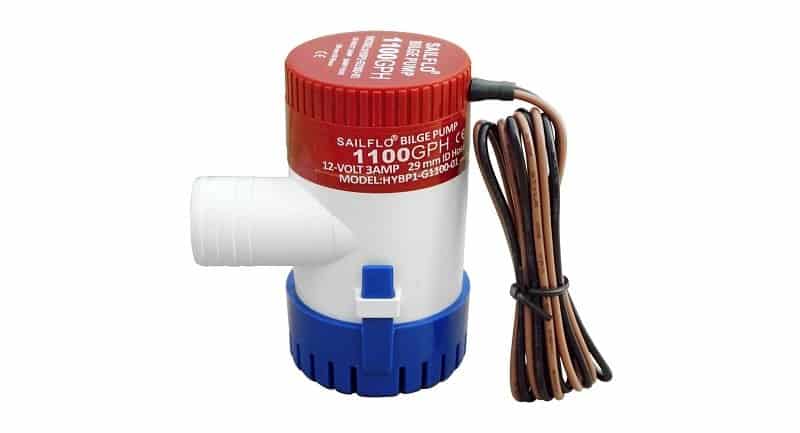
For boaters in need of a large volume pump but with tight budgets, the Eco-Worthy water pump is an ideal solution. It boasts a flow rate of up to 1,100 GPH, and it costs less than $25. Even if the product doesn’t tick the right boxes, you really can’t complain about the price.
The flow rate is impressive, but the overall power of the pump is pretty good too, being able to pump water up to 13 ft without struggling too much. For a small 12-volt pump, it’s quite the over achiever.
One of the most talked about features of this pump is the fact that it runs very quietly. In fact, it’s almost silent (if properly installed) and vibration is at a minimum. Maintenance is also fairly quick and painless thanks to the addition of snap-lock strainers, which filter out any detritus and keep your machine running smoothly.
It’s a submersible pump, so it’s built with tough components to defend against harsh marine environments and salt water in particular. For example, it features moisture-tight seals and washers, ignition protection, rust and corrosion protection, stainless steel components, and anti-airlock technology. It can handle the conditions, and the tough components ensure that it will have a long life.
Pros
Manual pump, but can be made automatic with float switch
Anti-airlock protection
High-quality rust and corrosion-proof components.
Pump Capacity: 1,100 GPH (Claimed)
DasMarine 3000 GPH 12V Pump
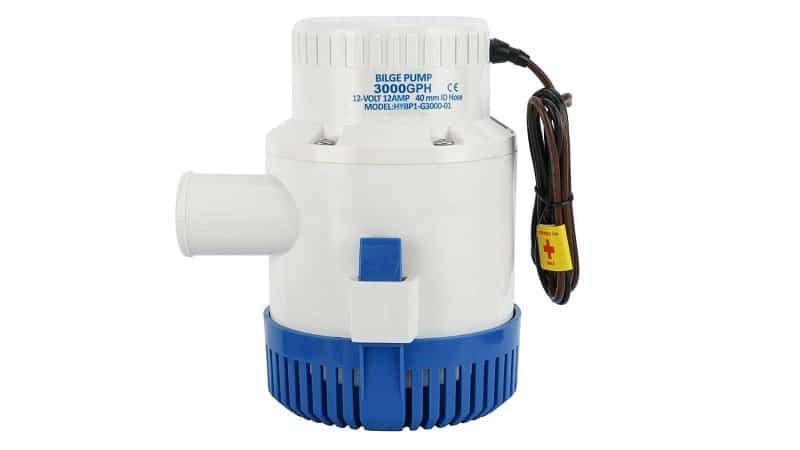
Lastly, we’ve got this fairly heavy-duty pump from DasMarine. This is a fully-submersible 12 volt pump that’s tough, efficient, easy to install, and relatively inexpensive. Yes, there are cheaper products out there, but there are also more expensive ones too. If you’re looking for a reliable pump that can be used for a wide range of marine applications, then this is a good one to own.
The pump is made from a number of durable, waterproof, rustproof, and corrosion-proof materials, including plastic and stainless steel. It’s built to withstand high-impacts, resist the effects of salt-water, and keep out any unwanted debris or detritus. It has a very useful quick-release strainer for that reason!
DasMarine’s pump claims to displace up to 3,000 GPH, which quite a high-capacity output for such a small machine. It pumps water well, but won’t drain your battery in the process either, since it boasts an efficient, low current draw. Other cool features include ignition protection, water-cooling for the motors, anti-airlock protection, and assurance that it won’t burn out when run dry.
For those looking for a supremely efficient pump that runs silently and vibration-free, that won’t fall apart the minute it’s up to its neck in water, then this is a product worth considering.
Pros
Highly efficient low current draw
100% submersible
Versatile, and can be used for boats, spas, bait tanks and more
Pump Capacity: 3,000 GPH (Claimed)
Bilge Pump Buying Guide: All You Need To Know
Now that you’ve got a snapshot of some of the best products on the market, how do you know which one will suit you best?
We’ve put together a short buying guide that covers all of the most important features to look out for when choosing a new pump. Not all pumps are the same, and different types have different strengths and weaknesses. This is just a quick outline of the different types available and what important features that you need to look for, but armed with this knowledge, you should be able to find a pump that suits your needs, fits your budget, and keeps your bilge as water-free as possible!
The Different Bilge Pump Types
For small vessels, a hand pump is fine, but for bigger watercraft, an electric 12v bilge pump will be better. Electric pumps come in a couple of different styles. For the most part, how they operate isn’t that important but we’ll mention the two types before carrying on with the buying guide.
Centrifugal Pumps
Centrifugal pumps operate by using kinetic energy via a rotating impeller. This draws water into the turbine on one side, and discharges it out of the other. These pumps are submersible but they’re not self-priming—that means that they need to be in water to operate. These pumps are easy to maintain, relatively cheap, and have a great output rate.
Since they agitate the water as they process it, any water with oil traces can quickly turn to goo, making the pump almost unusable.
Diaphragm Pumps
Diaphragm pumps are like little aqua vacs. They use vacuum technology to pull water into an intake, and push it out the other side. They don’t need to be submerged to operate (they are self-priming), and they can run dry without causing damage. They can push water to higher heights than centrifugal pumps, but they suffer from a slower flow rate, and can’t handle any dirt or debris.
So what type should you use? For small craft, a centrifugal pump is the king. It can shift water easily, and do it well. Larger craft may want to have a diaphragm pump, but with a centrifugal pump as a backup. But there are other pump details that you should think about before investing.
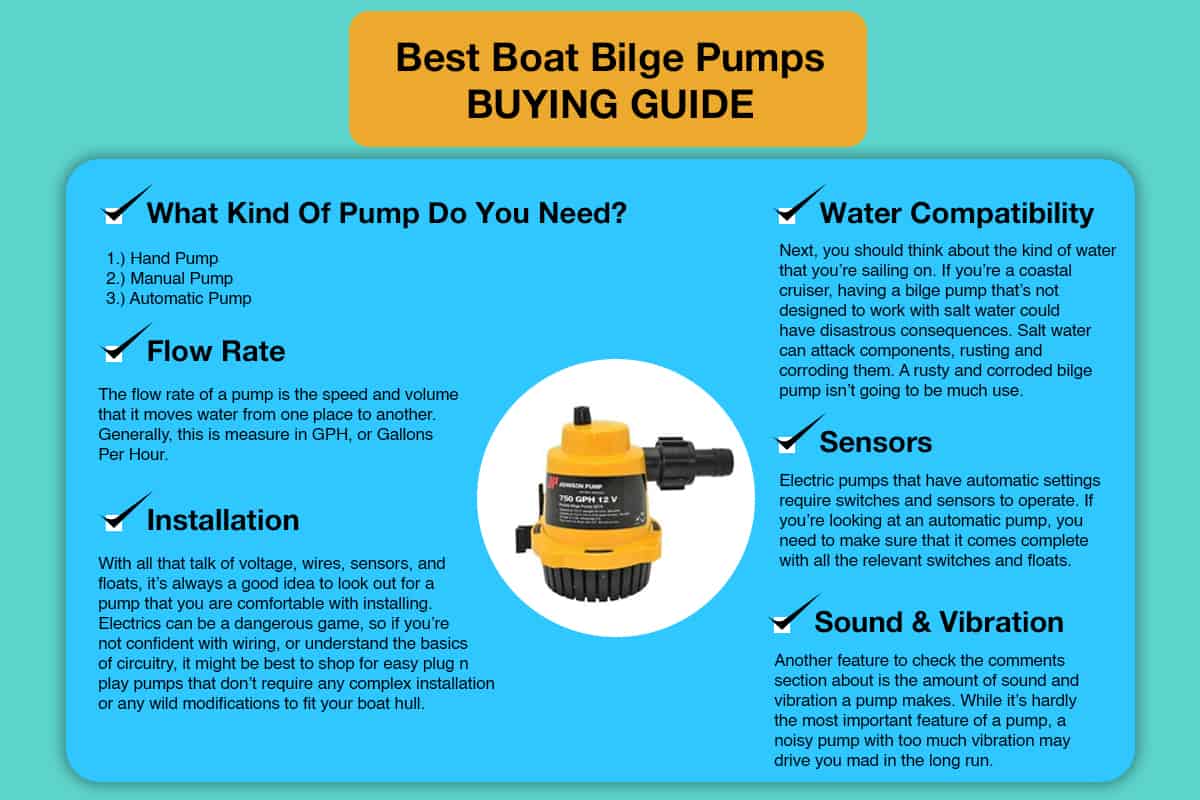
What Kind Of Pump Do You Need?
Hand Pump
Hand pumps are best suited to kayaks, canoes, and small boats. They’re designed to deal with small volumes of water, like a puddle of rain water in a hull, or a few splashes from a rogue wave. They operate like a bicycle pump, and don’t rely on any external power other than your own muscle. These pumps are cheap, practical, and very useful.
Manual Pump
Manual pumps, or rather manual electric pumps, are small compact pumps that sit in your hull, and only begin pumping out water when you switch them on. These pumps are great, and since they don’t rely on any special floats or sensors, they’re very easy to install. Pumps like these are often inexpensive and quite durable too.
Automatic Pump
Automatic pumps require the use of sensors of a float switch, which detect the water level and switch on to deal with it instantly. These pumps are great for those who don’t want the hassle of manually turning things on. They’re not 100% reliable though, so it’s a wise idea to buy one with a manual switch installed so that you can turn it on when you need it.
Features To Look Out For
Flow Rate
The flow rate of a pump is the speed and volume that it moves water from one place to another. Generally, this is measure in GPH, or Gallons Per Hour. This is one of the most important features to pay attention to.
The GPH is important but the number printed on the box isn’t going to be accurate. 500 GPH suggests that a pump could move 500 gallons from one place to another in 60 minutes. Unfortunately, real word conditions and other variables affect that figure greatly. The depth of the water, the length of the hose, the strength of the voltage…these things will reduce a pump’s real pumping power considerably. Always expect far less than quoted.
Still, these figures give a good indication of a pump’s capability. For boats up to 18 ft, a 500 GPH pump will do. Up to 22 ft, you may want to consider a 700 GPH model. All boats over 26 ft will need something over 1,000 GPH at the very least. The more gallons a pump can shift, the better, but for the best results, it’s always wise to have two pumps on the go, rather than just relying on one.
Really small craft, like kayaks and row boats are fine to operate with just a hand bilge pump.
Installation
With all that talk of voltage, wires, sensors, and floats, it’s always a good idea to look out for a pump that you are comfortable with installing. Electrics can be a dangerous game, so if you’re not confident with wiring, or understand the basics of circuitry, it might be best to shop for easy plug n play pumps that don’t require any complex installation or any wild modifications to fit your boat hull. Fortunately, there are plenty of pre-packaged, easy-installation models out there.
Water Compatibility
Next, you should think about the kind of water that you’re sailing on. If you’re a coastal cruiser, having a bilge pump that’s not designed to work with salt water could have disastrous consequences. Salt water can attack components, rusting and corroding them. A rusty and corroded bilge pump isn’t going to be much use.
Even if you don’t deal with salt water, look for pumps with high quality components that can handle salty and dirty water. Oil can often get sucked into pumps too, which causes poorly made machines to gum up and fail. Stainless steel fittings, tough plastic, and strong rubber seals are very important things to keep in mind.
Sensors
Electric pumps that have automatic settings require switches and sensors to operate. If you’re looking at an automatic pump, you need to make sure that it comes complete with all the relevant switches and floats. If it doesn’t, then you’re basically buying a manual pump, and you’ll need to source and install the switches and sensors yourself.
Always make sure you know what you’re buying. If in doubt, read the reviews; if a product comes without the things you’d expect, you can bet that someone in the comments and reviews section has mentioned it. Probably quite explicitly too.
Sound & Vibration
Another feature to check the comments section about is the amount of sound and vibration a pump makes. While it’s hardly the most important feature of a pump, a noisy pump with too much vibration may drive you mad in the long run. If a sound annoys you, or a vibration bothers you, then it will make you hate using your boat. It’s best to look for a quiet bilge pump that won’t drive you insane. The reviews will give you real insight into the noise levels of a pump. No manufacturer is going to go out of their way to state that their product is a noisy machine.
Portability
Do you want a pump that you can use for a variety of vessels? Or do you need one that’s going to be bolted down and hard wired into your ship’s hull? If you own a number of boats or kayaks, then something that’s small, easy to remove and install, and compact enough to be moved around will be a better investment. Usually, the more portable a pump is, the less powerful it is.
What Is The Best Bilge Pump? In Summary
Even with all of this information and following our buying guide, choosing a pump that suits your needs is no easy task. To make life a little bit easier, here are our top favorites, the best of the best, as it were. Here’s the TL:DR summary for the best of the bilge pumps:
The best bilge pump for boaters on a budget is the Shoreline Marine 600. It’s a small and compact, fully-submersible, automatic pump that has a decent flow rate of up to 600 GPH. Technically, it’s actually a manual pump, but it’s designed to accommodate a float switch that can make it automatic. It’s very cheap, so the fact that you might have to buy a few extras shouldn’t put you off of buying this great little pump.
If you’ve got more cash to play with and you’re looking for a heavy-duty pump that will do the job and then some, then the Rule 2000 is the way to go. Designed for large vessels of over 28 ft, the Rule 2000 can competently shift water in high volumes to heights of up to 10ft and up gentler inclines to over 20ft. In all, it boasts 2000 GPH, and if that’s not enough, Rule sells bigger pumps for even bigger performance.
But if you’re looking for the best pump overall, then we would have to recommend the Johnson Pro-Line marine pump. It’s a submersible, manual pump that can be turned into an automatic one. It’s versatile, compact, and comes with impressive performance and some useful features. The flow rate is 750 GPH, it has air-lock protection, ignition protection, a generic hose-attachment, and a removable strainer.
And if that wasn’t enough, it ships with a 3 year warranty from the manufacturer, which means that it’s a product that you can have confidence in!
Categories: Boats












1 Comment
Robert Hogward on June 27, 2021
I found your article very informative. Without the pump, the water will not move out of the tank. However, choosing a fresh water pump is overwhelming. There are many variables to take into account, from capacity to noise.
Again thanks!